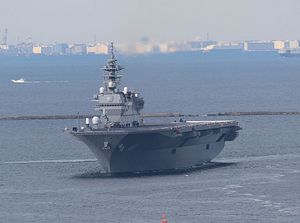The Japan Maritime Self Defense Force (JMSDF) commissioned its second Izumo-class helicopter carrier JS Kaga at the Japan Marine United shipyard in Yokohama, on March 22.
The commissioning ceremony was attended by a host of dignitaries including Japan’s Vice Defense Minister Takayuki Kobayashi, who openly addressed ongoing China-Japan tensions in the East China Sea and Beijing’s military buildup in the South China Sea his remarks.
“China is attempting to make changes in the East China Sea and the South China Sea with bases and through acts that exert pressure and are steadily altering the status quo, raising security concerns among the international community,” Kobayashi said, according to The Japan Times.
The 248-meter long Kaga displaces around 27,000 tons and–along with its sister ship Izumo (docked right next the Kaga during the March 22 commissioning ceremony)–will be the biggest surface warship operated by the Japanese Navy since the end of World War II. The JMSDF officially classified the warships’ as helicopter destroyers in order to downplay the carriers’ offensive capabilities.
Officially, the Kaga’s primary role will be to conduct surveillance and humanitarian assistance and disaster relief missions. However, the carrier with its OQQ-22 bow-mounted sonar and fleet of torpedo-armed helicopters will boast excellent anti-submarine warfare capabilities.
“The ship is designed to accommodate up to 14 helicopters (seven Mitsubishi-built SH-60k ASW helicopters and seven Agusta Westland MCM-101 mine countermeasure helicopters), five of which can simultaneously take off and land, given the Izumo’s large flight deck and five landing spots,” I explained elsewhere.
Furthermore I noted:
While repeatedly denied by Japanese officials and with no official plans to acquire the aircraft in the future, the JMSDF could launch the F-35B is the U.S. Marine Corps variant of the supersonic fifth-generation F-35B Lightning II Joint Strike Fighter, capable of vertical or short takeoffs and vertical landings without requiring a catapult launcher [from the carrier] (…)
The JMSDF will more likely deploy a number of V-22 tilt-rotor aircraft — a hybrid between a conventional helicopter and turboprop plane with both vertical takeoff and landing (VTOL) and short takeoff and landing (STOL) capability — from the carrier. Japan has placed an order with the United States for a total of 17 V-22s and is expected to receive the first batch of aircraft in 2017.
The carrier is armed with two Raytheon RIM-116 Rolling Airframe Missile SeaRAM launchers and two Phalanx close-in weapon systems to defend against aerial threats.
Whereas the JS Izumo is part of the JMSDF’s Escort Flotilla 1 based in Yokosuka, Kanagawa Prefecture (also home to the U.S. Navy’s supercarrier USS Ronald Reagan) the JS Kaga will deploy with the Escort Flotilla 4, based in Kure, Hiroshima Prefecture.
The JS Kaga’s total construction costs are estimated at around 120 billion yen ($1.1 billion).
The JMSDF itends to dispatch the JS Izumo on a three-month deployment to the South China Sea beginning in May.

































